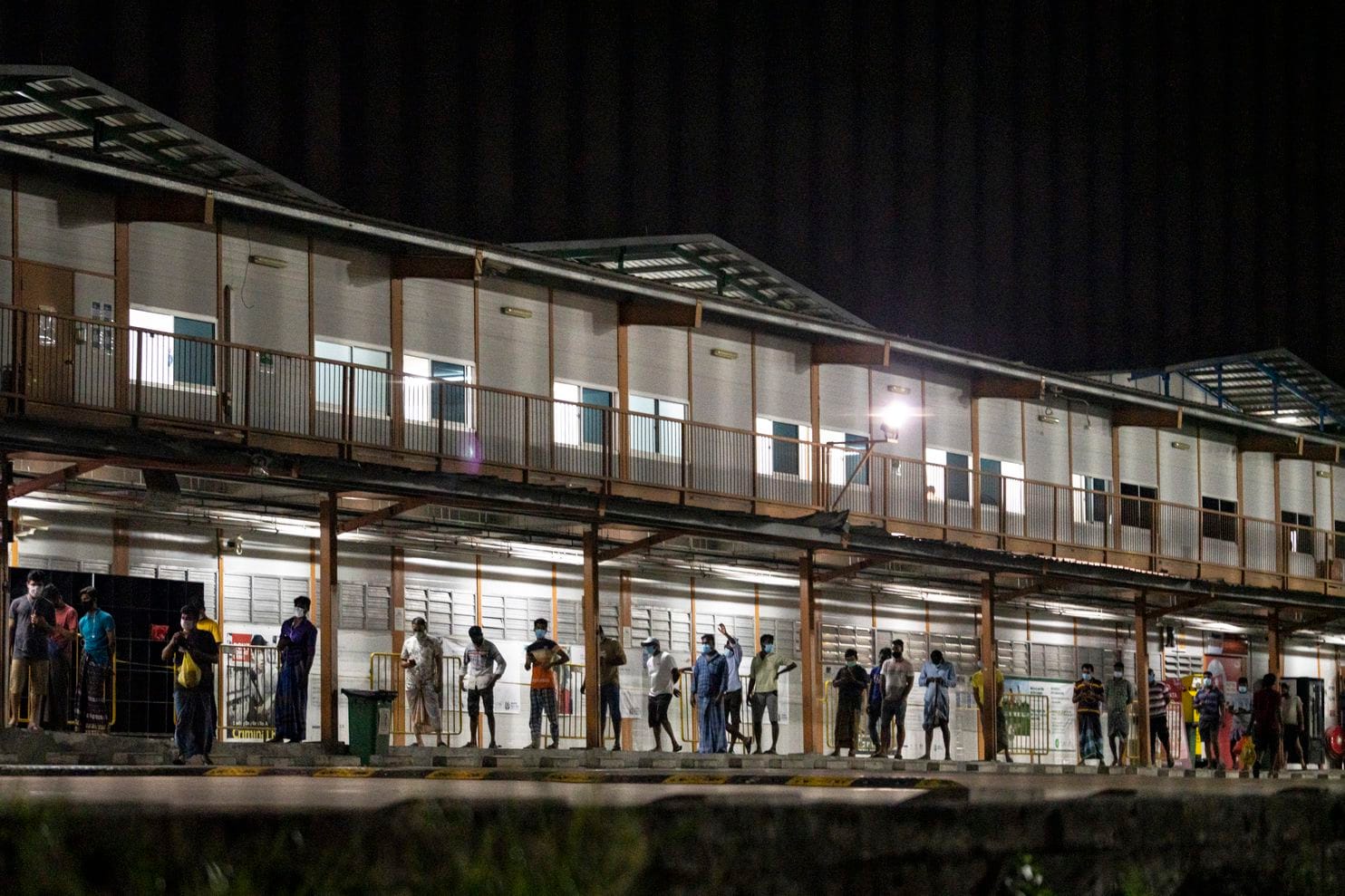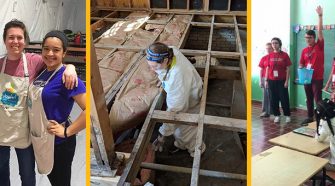Shekor arrived in Singapore a decade ago at age 17, one of many low-income migrant workers who have powered the city’s growth, building hospitals, subway lines and the Marina Bay Sands resort.
In his years working in aluminum production and on construction sites, the Bangladeshi national has suffered various work-related injuries. The most recent, on March 18, left him with searing pain in his left hip.
That was also the date that coronavirus infections in the city-state — whose early response epidemiologists had lauded as the gold standard — began soaring, from 313 then to more than 9,000 as of Tuesday, after two days of record jumps.

Almost 70 percent of Singapore’s coronavirus cases are concentrated in migrant dormitories.

Singapore’s migrant workers face a heightened risk of infection because of overcrowded living quarters, poor nutrition, limited access to health care and personal protective equipment, low wages and, in some cases, discrimination.
LEFT: Almost 70 percent of Singapore’s coronavirus cases are concentrated in migrant dormitories. RIGHT: Singapore’s migrant workers face a heightened risk of infection because of overcrowded living quarters, poor nutrition, limited access to health care and personal protective equipment, low wages and, in some cases, discrimination.
TOP: Almost 70 percent of Singapore’s coronavirus cases are concentrated in migrant dormitories. BOTTOM: Singapore’s migrant workers face a heightened risk of infection because of overcrowded living quarters, poor nutrition, limited access to health care and personal protective equipment, low wages and, in some cases, discrimination.
Thousands of new cases — and almost 70 percent of Singapore’s total — are concentrated in dormitories that house migrant workers, who have been locked down in their quarters as authorities seek a solution. For Shekor, who gave only his first name for fear of retribution from his employer, it means no access to painkillers he needs just to sleep.
“Everything is so difficult for everybody here,” he said in a phone interview from his dormitory of 25,000, where hundreds have been infected. “It seems like they only take the most serious ones to hospital; the normal ones like me, no one takes care of us.”
The situation highlights the vulnerability of migrant workers, who in Singapore make up one-third of the labor force. Their risks of infection are exacerbated by overcrowded living quarters, poor nutrition, limited access to health care and personal protective equipment, low wages and, in some cases, discrimination.
[Sign up for our Coronavirus Updates newsletter to track the outbreak. All stories linked in the newsletter are free to access.]
 A construction site in Singapore lies empty on April 11 during a halt to nonessential work to stem the spike in coronavirus cases.
A construction site in Singapore lies empty on April 11 during a halt to nonessential work to stem the spike in coronavirus cases. In the Persian Gulf, laborers’ quarters also have become infection hotspots. As in Singapore, many migrant laborers are from South Asia. Elsewhere, African migrants in China are facing discrimination and xenophobia, refused entry into restaurants or evicted from their homes. Singapore’s largest Chinese-language broadsheet, Lianhe Zaobao, recently published a letter from a reader who blamed the migrants for the outbreaks, labeling their countries “backward” and their practices dirty.
In Singapore, critics say these events have revealed a hubris among the authorities and the wider community, who took for granted their initial success in keeping infection numbers low while failing to prepare for the possibility of an outbreak among the most downtrodden.

A worker on a dormitory balcony.

Workers hang out in a dormitory compound. About a dozen compounds have been put on quarantine, which means workers are confined to their rooms.
LEFT: A worker on a dormitory balcony. RIGHT: Workers hang out in a dormitory compound. About a dozen compounds have been put on quarantine, which means workers are confined to their rooms.
TOP: A worker on a dormitory balcony. BOTTOM: Workers hang out in a dormitory compound. About a dozen compounds have been put on quarantine, which means workers are confined to their rooms.
“For the first two months, we engaged in a lot of self-congratulation,” said Alex Au, vice president of rights group Transient Workers Count Too (TWC2). “If anyone had cared to look, the dangers were already there.”
Authorities had planned for the epidemic with a focus only on citizens, he said, distributing surgical masks, hand sanitizer and reusable masks only to Singaporean households. Singaporean residents returning from the United States and Britain, meanwhile, were put up in four- and five-star hotels paid for by the government.
“This reflects the deliberate invisibilization of the foreign worker; the whole machinery of state operates as though they don’t exist,” Au said.
 A volunteer at the Migrant Workers Center helps organize bottles of hand sanitizer that will be distributed to the workers.
A volunteer at the Migrant Workers Center helps organize bottles of hand sanitizer that will be distributed to the workers. HealthServe, a nonprofit providing subsidized health care to migrant workers, said migrants had been anxious as early as February about the virus and their level of risk in overcrowded living conditions. But a change in regulations meant volunteer doctors and nurses staffing the organization’s nonprofit clinics could no longer serve part-time, forcing it to cut services by 90 percent.
“This was a situation we felt was going to come, even if we were hoping for the best,” said Suwen Low, spokeswoman for HealthServe.
A spokesman for the Ministry of Manpower responded to a request for comment from The Washington Post with a news release, issued April 14, saying that authorities are working to “reduce the number of workers in the dormitories and also implement a medical support plan at all dormitories.”
Workers in essential services have been moved out of dormitories, the ministry said, while officials were identifying alternative accommodations for others, such as army camps, sports halls, vacant housing blocks and shipping containers.
“Our immediate priority for the workers in the dormitories is to help them stay healthy and minimize the number that get infected,” said Josephine Teo, Singapore’s manpower minister, in a news conference last week.
In an address to the nation on Tuesday, Singapore prime minister Lee Hsien Loong began by noting that the number of new cases in the local community has leveled off before acknowledging the problematic sharp rise in total cases overwhelmingly among migrants.
“We will care for you just like we care for Singaporeans,” he said. “We will look after your health, your welfare and your livelihood.”

HealthServe volunteers prepare to attend to patients at a clinic. The organization provides low-cost medical services to migrant workers.

Migrant workers wait to be seen at a HealthServe clinic.
LEFT: HealthServe volunteers prepare to attend to patients at a clinic. The organization provides low-cost medical services to migrant workers. RIGHT: Migrant workers wait to be seen at a HealthServe clinic.
TOP: HealthServe volunteers prepare to attend to patients at a clinic. The organization provides low-cost medical services to migrant workers. BOTTOM: Migrant workers wait to be seen at a HealthServe clinic.
Authorities are also working with organizations such as the Migrant Workers Center, which has a program of “ambassadors” who are helping their colleagues and friends understand hygiene practices, social distancing and practicalities like how to send remittances online. Yeo Guat Kwang, the group’s chairman, said the focus should be on improving conditions in the future.
“In hindsight, everyone would be wiser,” Yeo said. “But this is really an unprecedented global pandemic.”
A second wave of coronavirus infections began taking root in Singapore in mid-March, similar to other places in Asia, like Hong Kong and Taiwan, as residents abroad flocked back to the region when outbreaks intensified in Europe and the United States. But while Hong Kong managed this spike, getting new cases down to single-digits for more than eight days straight, and Taiwan recorded several days this month with no new cases, Singapore now has among the highest number of cases per capita globally.
The migrant workers bearing the brunt of the outbreak are overwhelmingly male and employed in construction and other labor-intensive sectors that Singaporeans avoid. The typical construction worker in Singapore earns about $430 a month, while the median monthly income for Singaporeans is $3,227.
“To keep them cheap, we have to exploit,” said Au from TWC2. “We pack them into [trucks], we pack them into dormitories, and now, when a crisis hits, they have no buffer.”
Clusters have been identified in many dormitories. More than a dozen dormitories have been placed under quarantine, meaning workers cannot leave their rooms, while nearly all dormitory residents are now barred from leaving the facilities, which are guarded by police.
The more than 200,000 dormitory residents are now anxious, bored, isolated and scared. Unable to buy their own groceries, cook for themselves or purchase phone cards to call home, they are almost completely dependent on charity and handouts.

Migrants wait outside the grocery store at the Migrant Workers Center. The workers are overwhelmingly male and employed in construction and other labor-intensive sectors that Singaporeans avoid.

Migrants leave the store with their purchases. The typical construction worker in Singapore earns about $430 a month, while the median monthly income for Singaporeans is $3,227.
LEFT: Migrants wait outside the grocery store at the Migrant Workers Center. The workers are overwhelmingly male and employed in construction and other labor-intensive sectors that Singaporeans avoid. RIGHT: Migrants leave the store with their purchases. The typical construction worker in Singapore earns about $430 a month, while the median monthly income for Singaporeans is $3,227.
TOP: Migrants wait outside the grocery store at the Migrant Workers Center. The workers are overwhelmingly male and employed in construction and other labor-intensive sectors that Singaporeans avoid. BOTTOM: Migrants leave the store with their purchases. The typical construction worker in Singapore earns about $430 a month, while the median monthly income for Singaporeans is $3,227.
A worker in one of the worst-hit dormitories, who only wanted to be identified by his first name, Ali, was treated for a sore throat and fever before the lockdown, and placed on sick leave until April 9. He was given an “advisory for patients with respiratory tract infection” — a status that means he has to isolate himself from others or be fined $7,000.
That was impossible in his 12-person room, he said. Ali’s cough persisted, but under lockdown, he was unable to seek medical attention for several days.
“Who will give me any treatment or help?” he said in an interview. “I am so scared I will die before any help comes.”
Authorities say that infected dormitory residents have been linked through common work sites, and through places like shopping malls, where many gather on their days off. In the dormitories, before the lockdown, men were able to socialize with each other and cook together, a distraction from their physically demanding jobs and the difficulty of being away from their families.
In an interview Thursday, Ali said he was finally able to see a doctor, who gave him cough syrup and tested him for the coronavirus. He has not heard back. His 11 roommates are trying to keep their distance from each other, but find it near impossible. On a trip to the bathroom on Thursday evening, he found that there was no hand soap.
In the evenings, he passes the time by reading engineering books and speaking to his family.
“I told my brother about my symptoms, and he explained it to my mother back in Bangladesh,” he said. “She just started crying.”
Jennifer Chowdhury in Dhaka, Bangladesh contributed to this report. Photo editing by Olivier Laurent. Design by Joanne Lee.



















